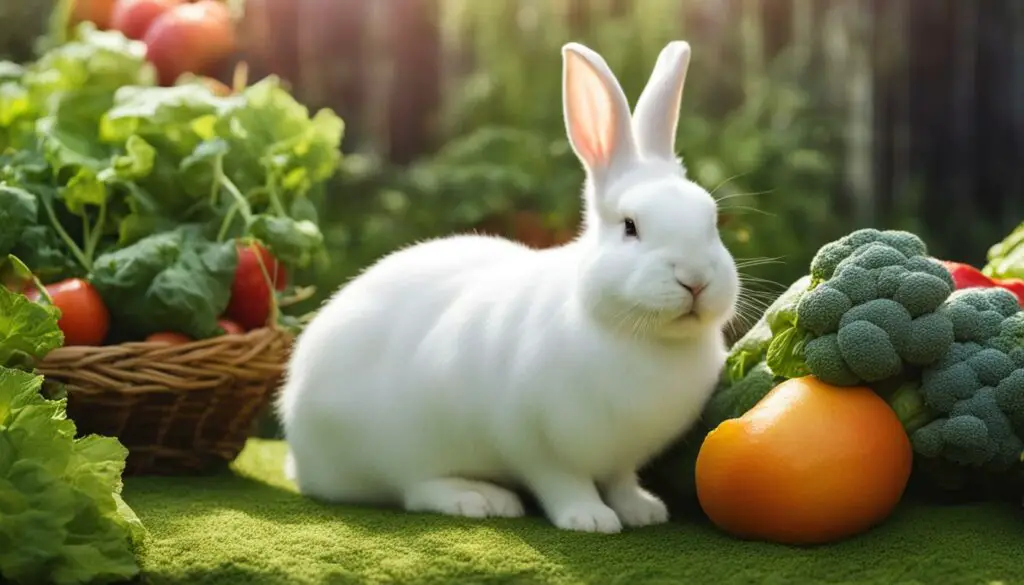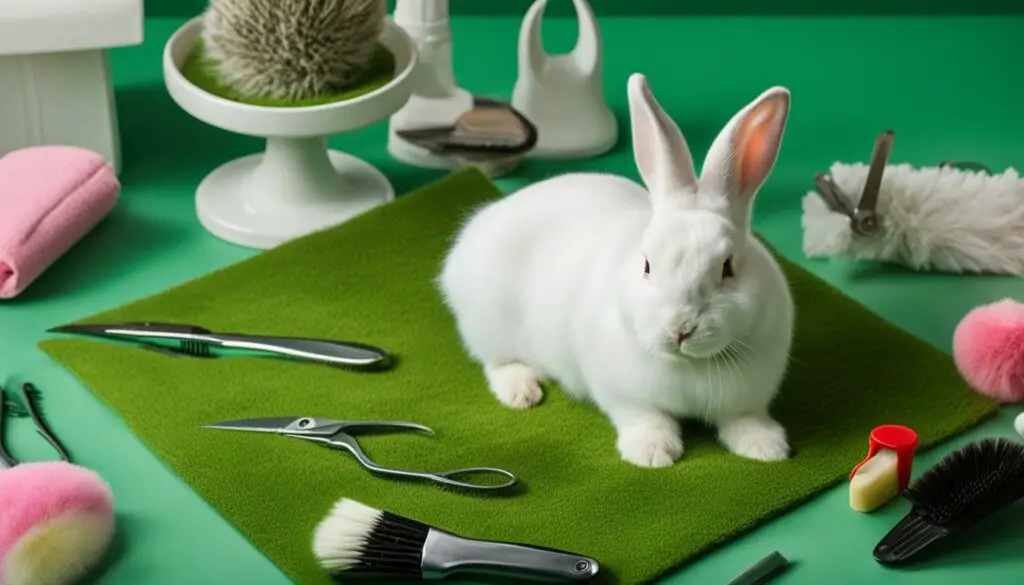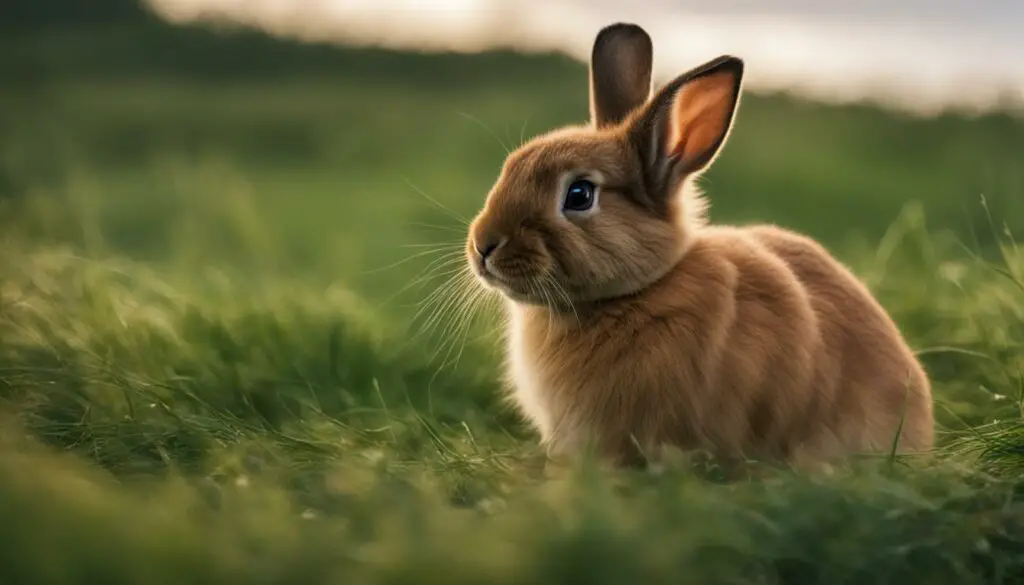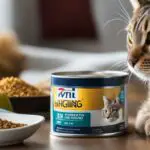As a rabbit owner, you may have noticed that your bunny is shedding excessively. It can be a cause for concern, but understanding the reasons behind this shedding can help you manage and reduce the issue. In this article, I will explore the causes of bunny shedding, how to promote healthy hair growth, and provide effective grooming tips to help you address this common concern.
Key Takeaways:
- Seasonal changes can contribute to bunny shedding as rabbits naturally shed their fur to adapt to different weather conditions
- Excessive bunny shedding may indicate underlying health issues and should be monitored closely
- A balanced diet and regular grooming can promote healthy hair growth and reduce shedding
- Proper environmental factors and stress management are important in managing bunny shedding
- Seeking professional assistance for bunny grooming can provide valuable guidance and support
Understanding Bunny Shedding: Seasonal Changes and Natural Cycles
One of the primary factors contributing to bunny shedding is seasonal changes. Rabbits naturally shed their fur as a way to adapt to different weather conditions. Spring and fall are common shedding seasons for rabbits, as their coats thin and thicken to regulate body temperature. This shedding is part of their natural cycle and should not be a cause for major concern. However, there are steps that can be taken to manage and minimize shedding during these seasons.
During seasonal shedding, it is important to provide your bunny with a healthy diet that supports hair growth. Foods rich in nutrients such as vitamins, minerals, and protein can aid in maintaining a healthy coat. Additionally, regular grooming can help manage shedding by removing loose fur and preventing matting. Gentle brushing with a soft-bristle brush or a grooming mitt can be effective in keeping your bunny’s fur healthy and reducing shedding.
While seasonal shedding is a natural process, if you notice excessive or sudden hair loss in your bunny, it may be a sign of underlying health issues. In such cases, it is recommended to consult a veterinarian for a thorough examination and proper diagnosis. By understanding the natural shedding patterns of rabbits and taking necessary precautions, you can ensure the overall well-being of your furry friend.
| Seasonal Bunny Shedding Tips | Managing Bunny Shedding Techniques |
|---|---|
|
|
Causes of Excessive Bunny Shedding
Excessive bunny shedding can be a concern for many rabbit owners, as it may indicate underlying health issues. Understanding the causes of excessive shedding is crucial in order to address the problem effectively. Several factors can contribute to excessive bunny shedding, including:
- Poor diet: A diet lacking in essential nutrients can affect the overall health of a bunny and lead to excessive shedding. Ensure that your bunny’s diet includes high-quality hay, fresh vegetables, and limited pellets to promote healthy hair growth.
- Stress: Stressful environments or situations can cause rabbits to shed more than usual. Loud noises, sudden changes in routine, and overcrowded living spaces can all contribute to stress-related shedding.
- Allergies: Just like humans, rabbits can develop allergies to certain foods, bedding materials, or environmental factors. Allergic reactions can cause excessive shedding as the body tries to eliminate the allergen.
- Hormonal imbalances: Hormonal changes, such as those caused by reproductive cycles or medical conditions, can disrupt the normal hair growth cycle in rabbits and lead to excessive shedding.
- Parasites and skin infections: Infestations of mites, fleas, or other parasites can irritate a rabbit’s skin, causing them to scratch and pull out their fur. Skin infections can also lead to increased shedding.
If you notice a sudden or significant increase in your bunny’s shedding, it’s important to consult a veterinarian. They can help identify the underlying cause and recommend appropriate treatment options.
“Excessive bunny shedding can be a sign of poor diet, stress, allergies, hormonal imbalances, or skin issues. If you’re concerned about your bunny’s shedding, consult a veterinarian for proper diagnosis and treatment.”
Remember, proper nutrition, stress management, and regular veterinary care are essential in maintaining a healthy coat for your bunny. By addressing the causes of excessive shedding, you can help your furry friend maintain a lustrous and healthy coat.
| Cause | Symptoms | Treatment |
|---|---|---|
| Poor diet | Brittle fur, weight loss, nutritional deficiencies | Consult a veterinarian for dietary recommendations and supplements |
| Stress | Agitation, excessive grooming, loss of appetite | Create a calm and secure environment, provide mental stimulation, and seek veterinary advice if necessary |
| Allergies | Itchy skin, redness, sneezing | Identify and eliminate the allergen, and consult a veterinarian for anti-allergy medications if needed |
| Hormonal imbalances | Changes in behavior, abnormal fur growth patterns | Consult a veterinarian for hormone tests and potential medical interventions |
| Parasites and skin infections | Scratching, red patches, visible parasites | Treat the underlying cause with appropriate medications as recommended by a veterinarian |
Understanding the causes of excessive bunny shedding is the first step in addressing the issue. By providing a proper diet, minimizing stress, and seeking professional advice when needed, you can help your bunny maintain a healthy coat and overall well-being.
Promoting Healthy Hair Growth in Bunnies
Proper nutrition and regular grooming are essential for promoting healthy hair growth in bunnies and reducing excessive shedding. By following these tips, you can help your bunny maintain a lustrous coat and minimize shedding.
Dietary Considerations
A balanced diet plays a significant role in promoting healthy hair growth in bunnies. Make sure to provide your furry friend with a variety of fresh vegetables, such as parsley, kale, and cilantro, as these leafy greens are rich in essential nutrients that support hair growth. Additionally, high-quality hay should make up the majority of your bunny’s diet, while pellets should be given in limited amounts. Avoid feeding sugary or starchy foods, as they can negatively impact your bunny’s fur quality and lead to increased shedding.
Grooming Techniques
Regular grooming sessions are crucial for managing bunny shedding. Use a soft-bristle brush or a grooming mitt to gently brush your bunny’s fur and remove loose hairs. This will help prevent matting, which can contribute to excessive shedding. While grooming, take the opportunity to inspect your bunny’s skin for any signs of irritation or infection. If you notice anything unusual, consult a veterinarian for further guidance.
| Grooming Tips for Promoting Healthy Hair Growth in Bunnies |
|---|
| Brush your bunny’s fur regularly with a soft-bristle brush or grooming mitt. |
| Inspect your bunny’s skin for any signs of irritation or infection during grooming sessions. |
| Avoid over-bathing your bunny, as it can strip their fur of natural oils and lead to dry skin. |
| Consult a veterinarian if you notice any significant changes in your bunny’s shedding patterns. |
Additional Considerations
In addition to a balanced diet and regular grooming, there are a few other factors to consider when promoting healthy hair growth in bunnies. Ensure that your bunny’s living environment is clean and free from excessive dust and allergens. Provide them with ample space for exercise and ensure proper ventilation to maintain optimal fur health. Avoid exposing your bunny to extreme temperatures or drafts, as these can impact their fur quality and potentially increase shedding.

Remember, each bunny is unique, and their shedding patterns may vary. By providing a healthy diet, practicing regular grooming, and creating a suitable living environment, you can help your bunny maintain a beautiful coat and minimize shedding.
Effective Grooming Tips for Managing Bunny Shedding
Proper grooming is essential for managing bunny shedding and maintaining a healthy coat. Here are some effective tips to help you keep your bunny’s fur in great condition:
Regular Brushing
Brushing your bunny regularly not only helps remove loose fur but also stimulates hair growth and prevents matting. Use a soft-bristle brush or a grooming mitt to gently brush your bunny’s fur in the direction of hair growth. This will remove any loose hairs and distribute natural oils that keep the fur soft and shiny.
Nail Trimming
Trimming your bunny’s nails is an important aspect of grooming. Overgrown nails can cause discomfort and may lead to injuries. Use a pair of small animal nail clippers and carefully trim the tips of the nails, taking care not to cut too close to the quick. If you’re unsure about nail trimming, consult a veterinarian or a professional rabbit groomer for assistance.
Ear Cleaning
Regular ear cleaning helps prevent wax build-up, infections, and mites in your bunny’s ears. Use a soft, damp cloth or a cotton ball soaked in a veterinarian-approved ear cleaning solution. Gently wipe the inner surface of the ears, being careful not to insert anything into the ear canal. Consult a veterinarian if you notice any unusual discharge, redness, or swelling in your bunny’s ears.
| Grooming Tip | Benefit |
|---|---|
| Providing a grooming mat or towel | Helps keep your bunny comfortable and secure during grooming sessions. |
| Using a gentle touch | Prevents any discomfort or stress for your bunny during grooming. |
| Offering treats and praise | Creates a positive association with grooming and strengthens the bond between you and your bunny. |
“Regular grooming not only keeps your bunny looking neat but also helps you detect any potential health issues early on. It’s an important part of overall bunny care.”
Remember, grooming sessions should be calm and stress-free for both you and your bunny. Take your time, be gentle, and make it a positive experience for your furry friend. If you have any concerns about grooming or need assistance, don’t hesitate to consult a professional rabbit groomer or a veterinarian specializing in small animals.

Identifying and Treating Health Issues That Cause Bunny Shedding
Excessive bunny shedding can sometimes be a sign of underlying health issues. If you notice a sudden or significant increase in your bunny’s shedding, it’s important to identify and address these potential health concerns. Here are some common health issues that can cause bunny shedding and how they can be treated:
1. Skin Infections:
Bacterial or fungal infections can lead to skin irritation and hair loss in rabbits. If your bunny has scaly or red patches on their skin, it’s crucial to consult a veterinarian for diagnosis and treatment. Depending on the severity of the infection, your veterinarian may prescribe topical medications or oral antibiotics to eliminate the infection and promote hair regrowth.
2. Parasites:
Parasites like fleas, mites, and ticks can also cause excessive shedding in bunnies. These parasites irritate the skin and can lead to hair loss. Your veterinarian will recommend appropriate parasite treatments, such as topical medications or oral medications, to eliminate the parasites and relieve your bunny’s shedding symptoms.
3. Hormonal Imbalances:
Hormonal imbalances, such as ovarian cysts, can affect a bunny’s fur growth and contribute to shedding. If your bunny is experiencing hormonal imbalances, your veterinarian may recommend hormonal therapy or surgical intervention to restore balance and reduce shedding.
It’s important to remember that only a veterinarian can accurately diagnose and treat these health issues. If you suspect that your bunny’s shedding is due to a health concern, seek professional help to ensure the best care for your furry friend.

| Health Issue | Symptoms | Treatment |
|---|---|---|
| Skin Infections | Scaly or red patches on the skin | Topical medications or oral antibiotics |
| Parasites | Presence of fleas, mites, or ticks | Topical or oral parasite treatments |
| Hormonal Imbalances | Abnormal fur growth, ovarian cysts | Hormonal therapy or surgical intervention |
Minimizing Stress to Reduce Bunny Shedding
Bunny shedding can be influenced by various factors, including stress. Minimizing stress is crucial in managing and reducing excessive shedding in rabbits. Creating a calm and secure environment for your bunny is essential to their overall well-being and can help minimize shedding.
Provide your bunny with a quiet space where they can retreat and feel safe. This can be a designated area in your home or a cozy hideaway within their enclosure. Hiding spots, such as tunnels or boxes, can offer a sense of security to reduce stress and minimize shedding.
Regular exercise is also important in reducing stress and maintaining a healthy bunny. Provide opportunities for daily exercise, such as supervised playtime in a bunny-proofed space or providing toys and interactive activities within their enclosure. Physical activity helps to release endorphins and reduces stress levels, which can in turn reduce shedding.
Avoid exposing your bunny to loud noises or sudden changes in routine, as these can be sources of stress. Additionally, make sure your bunny’s living environment is free from potential stressors, such as other aggressive pets or excessive handling by unfamiliar individuals. Maintaining a relaxed and stress-free environment will help minimize bunny shedding.

Expert Tip: Creating a Calming Environment
“Rabbits are highly sensitive animals, and stress can significantly impact their well-being and shedding patterns. By creating a calm and secure environment, you can help reduce stress and minimize excessive shedding. Provide them with a quiet space, exercise opportunities, and a stress-free living environment to keep their shedding in check.”
– Dr. Melissa Johnson, Rabbit Veterinarian
Importance of a Balanced Diet for Bunny Hair Growth
Proper nutrition plays a crucial role in promoting healthy hair growth in bunnies and reducing excessive shedding. A balanced diet ensures that your bunny receives all the essential nutrients necessary for maintaining a healthy coat. Include a variety of fresh vegetables, high-quality hay, and limited pellets in their daily meals. Leafy greens such as parsley, kale, and cilantro are particularly beneficial as they contain vitamins and minerals that support hair growth.
Feeding your bunny excessive amounts of sugary or starchy foods should be avoided, as these can negatively impact their fur quality and increase shedding. It’s important to remember that bunnies have sensitive digestive systems, so their diet should be carefully monitored and balanced. Consult with a veterinarian or a rabbit nutritionist to ensure that your bunny’s diet meets their specific nutritional needs.
| Nutrient | Sources |
|---|---|
| Protein | Timothy hay, fresh vegetables (broccoli, spinach), pellets |
| Vitamin A | Carrots, leafy greens (kale, parsley), sweet potatoes |
| Vitamin E | Leafy greens, wheat germ, sunflower seeds |
| Omega-3 Fatty Acids | Flaxseeds, chia seeds, walnuts |
| Zinc | Pumpkin seeds, cashews, oats |
Incorporating these nutrients into your bunny’s diet can help improve the health and growth of their fur. Remember to provide fresh water at all times and monitor their food intake to prevent overfeeding and obesity, which can have negative effects on their coat quality and overall health.

Expert Tip:
“A well-balanced diet is essential for promoting healthy hair growth in bunnies. It’s important to provide a variety of nutritious foods to meet their specific dietary needs. Additionally, regular veterinary check-ups can help ensure that your bunny remains in optimal health and their coat is in top condition.” – Dr. Rabbitologist, DVM
Assessing Environmental Factors for Managing Bunny Shedding
Promoting a Clean and Dust-Free Living Space
Creating a clean and dust-free living environment for your bunny is essential for managing shedding. Excessive dust and allergens can irritate their skin and contribute to increased shedding. Regularly clean your bunny’s enclosure by removing soiled bedding, vacuuming or sweeping up any loose fur or debris, and wiping down surfaces with a pet-safe cleaner. Additionally, consider using dust-free bedding materials and providing adequate ventilation to minimize the accumulation of dust and allergens.
Controlling Temperature and Humidity Levels
Extreme temperature and humidity levels can impact your bunny’s fur and potentially increase shedding. Avoid placing their enclosure in direct sunlight or drafty areas, as these conditions can stress your bunny and affect their coat. Maintain a comfortable temperature range of around 60-70°F (15-21°C) and a relative humidity level of 40-60% in the room where your bunny resides. This will help prevent temperature-related stress and excessive shedding.
Ensuring Proper Ventilation
Good ventilation is crucial for maintaining a healthy living environment for your bunny. Stagnant air can contribute to the accumulation of dust, allergens, and unpleasant odors, which can irritate your bunny’s skin and promote shedding. Ensure that your bunny’s enclosure has proper ventilation through the use of fans, open windows, or an air purifier. This will help keep the air fresh and clean, reducing the potential for shedding-related issues.
| Environmental Factors for Managing Bunny Shedding | Actions to Take |
|---|---|
| Promoting a Clean and Dust-Free Living Space | Regularly clean the enclosure, use dust-free bedding, and provide ventilation. |
| Controlling Temperature and Humidity Levels | Maintain a comfortable temperature range and relative humidity in the bunny’s environment. |
| Ensuring Proper Ventilation | Use fans, open windows, or an air purifier to maintain good airflow and minimize stagnant air. |
Minimizing Exposure to Potential Allergens
Bunnies can be sensitive to certain substances, such as strong fragrances, smoke, or certain cleaning products. These allergens can cause skin irritation and trigger shedding. Avoid using heavily scented products around your bunny and opt for pet-friendly, non-toxic cleaning solutions. Additionally, keep your bunny away from areas where smoking occurs and ensure proper ventilation when using any potentially irritating substances in your home.
Creating a Stress-Free Environment
Stress can contribute to excessive shedding in bunnies, so it’s important to create a calm and stress-free environment for your furry friend. Provide your bunny with plenty of hiding spots, quiet spaces, and opportunities for daily exercise. Limit exposure to loud noises, sudden changes in routine, and other potential stressors. By minimizing stress, you can help reduce shedding and promote overall well-being for your bunny.

Common Grooming Tools for Bunny Shedding Management
Proper grooming tools are essential for managing bunny shedding and maintaining a healthy coat. Here are some common grooming tools that can help you effectively manage your bunny’s shedding:
Gentle Soft-Bristle Brush
A gentle soft-bristle brush is a must-have tool for removing loose fur and preventing matting. Choose a brush specifically designed for small animals like bunnies, as it will have softer bristles that won’t irritate their sensitive skin. Regular brushing with a soft-bristle brush will help keep your bunny’s coat tidy and minimize shedding.
Grooming Mitt
A grooming mitt is another useful tool for managing bunny shedding. The mitt is worn on your hand and has a textured surface that helps to gently remove loose fur when you stroke your bunny’s coat. It is particularly effective for bunnies who are not comfortable with traditional brushes. Using a grooming mitt not only reduces shedding but also provides a soothing massage for your bunny.
Fine-Toothed Comb
A fine-toothed comb is ideal for removing tangles and matted fur from your bunny’s coat. It is especially useful for long-haired breeds or bunnies with thick coats. Gently comb through your bunny’s fur, starting from the base and working your way to the tips. Be careful not to pull or tug on the fur to avoid causing any discomfort to your bunny.
Remember to approach grooming sessions with patience and a gentle touch. Regular grooming using these tools will help keep your bunny’s coat healthy, reduce shedding, and strengthen the bond between you and your furry friend.

Table: Summary of Common Grooming Tools for Bunny Shedding Management
| Grooming Tool | Description |
|---|---|
| Gentle Soft-Bristle Brush | A brush with soft bristles designed for small animals like bunnies. Helps remove loose fur and prevent matting. |
| Grooming Mitt | A mitt worn on your hand with a textured surface that gently removes loose fur while providing a soothing massage for your bunny. |
| Fine-Toothed Comb | A comb with fine teeth for removing tangles and matted fur from your bunny’s coat, especially useful for long-haired breeds. |
Seeking Professional Assistance for Bunny Grooming
Bunny grooming is an important aspect of managing shedding and promoting the overall health and well-being of your furry friend. While regular grooming sessions at home can be effective, there may be times when seeking professional assistance is beneficial. Professional rabbit groomers are experienced in handling and grooming bunnies, ensuring their safety and comfort throughout the process.
When it comes to bunny grooming, professional groomers can provide valuable guidance on proper techniques and tools. They can recommend the best grooming tools for your bunny’s specific needs and help address any concerns you may have related to shedding. Additionally, professional groomers have the knowledge and expertise to identify and treat any underlying skin conditions or health issues that may be causing excessive shedding.
“Professional rabbit groomers are experienced in handling and grooming bunnies, ensuring their safety and comfort throughout the process.”
By seeking professional assistance for bunny grooming, you can ensure that your bunny receives the care and attention they need to maintain a healthy coat and minimize shedding. Grooming sessions with a professional groomer can also be a stress-free and enjoyable experience for your bunny, as they are familiar with the grooming process and know how to handle rabbits with care and gentleness.
Benefits of Professional Bunny Grooming:
- Expert knowledge on proper grooming techniques and tools
- Identification and treatment of underlying health issues causing shedding
- Promotion of a stress-free and enjoyable grooming experience for your bunny
- Ensuring the safety and comfort of your bunny throughout the grooming process
To find a professional rabbit groomer in your area, consider asking for recommendations from your veterinarian or local rabbit rescue organizations. They may be able to provide you with trusted referrals and ensure that your bunny receives the best grooming care possible.
Maintaining a Bond with Your Bunny While Managing Shedding
Managing bunny shedding is not just about reducing hair loss; it’s also about maintaining a strong bond with your furry friend. Building and nurturing this bond is crucial for your bunny’s overall well-being and happiness. Here are some tips to help you maintain that special connection while managing shedding.
Regular playtime and bonding sessions
Take the time to schedule regular playtime and bonding sessions with your bunny. Engage in interactive activities such as puzzle toys, hide-and-seek games, or gentle petting sessions. This not only strengthens your bond but also provides mental stimulation for your furry friend and helps alleviate any stress they may be experiencing.
Use grooming sessions as bonding opportunities
Grooming your bunny can be an excellent bonding experience. Use grooming sessions as an opportunity to connect with your bunny on a deeper level. Make sure to choose a gentle approach, offering treats and praise during the grooming process. This way, your bunny will associate the grooming sessions with positive experiences and a close bond with you.
Provide a calm and secure environment
Creating a calm and secure environment for your bunny is essential for maintaining a strong bond. Ensure that your bunny has a quiet and designated space where they can retreat when they need some alone time. Avoid exposing them to loud noises or sudden changes in their routine, as these can cause stress and strain your bond with them.

Implementing a Shedding Management Plan for Your Bunny
Successfully managing bunny shedding requires a comprehensive plan that addresses all aspects of your bunny’s needs. By incorporating regular grooming, a balanced diet, and monitoring their environment, you can minimize the impact of shedding on your furry friend’s well-being.
Grooming Sessions
Regular grooming sessions are essential for managing bunny shedding. Use a soft-bristle brush, grooming mitt, or fine-toothed comb to remove loose fur and prevent matting. Set up a dedicated grooming area with a non-slip surface to make the process comfortable for both you and your bunny. Approach grooming with patience and a gentle touch, rewarding your bunny with treats and praise to create positive associations.
Balanced Diet
A balanced diet plays a crucial role in promoting healthy hair growth and reducing excessive shedding. Provide your bunny with high-quality hay, fresh vegetables, and limited pellets. Leafy greens like parsley, kale, and cilantro are rich in essential nutrients that support hair growth. Avoid feeding them sugary or starchy foods, as these can negatively impact their fur quality and increase shedding.
| Grooming Techniques | Bunny Diet |
|---|---|
|
|
Monitoring the Environment
Your bunny’s environment can also affect their shedding patterns. Keep their living area clean and free from excessive dust and allergens. Provide ample space for exercise and ensure proper ventilation. Avoid placing their enclosure in direct sunlight or drafty areas, as extreme temperatures can affect their fur and potentially increase shedding.
By implementing a shedding management plan that includes regular grooming, a balanced diet, and monitoring their environment, you can ensure the well-being of your bunny and minimize the impact of shedding on their overall health.

Conclusion
In conclusion, excessive bunny shedding can be a cause for concern, but understanding the reasons behind it is essential for effective management. By addressing the causes of bunny shedding, promoting healthy hair growth, and implementing proper grooming techniques, you can minimize excessive shedding and keep your bunny happy and healthy.
One of the primary factors contributing to bunny shedding is seasonal changes. Spring and fall are common shedding seasons for rabbits, as their coats adapt to different weather conditions. While this shedding is natural, it’s important to manage and minimize shedding during these seasons through regular grooming and maintaining a clean living environment.
If you notice a sudden or significant increase in shedding, it may be a sign of underlying health issues. Poor diet, stress, allergies, hormonal imbalances, parasites, and skin infections can all contribute to excessive shedding in rabbits. Monitoring your bunny’s shedding patterns and seeking veterinary assistance when necessary is crucial to identify and treat any health issues.
Regular grooming, a balanced diet, and a stress-free environment are key to managing bunny shedding. Brushing your bunny’s fur gently to remove loose hair, providing a nutritious diet that includes high-quality hay and fresh vegetables, and creating a calm living space are all important aspects of bunny grooming and shedding management.
Remember, maintaining a strong bond with your bunny is just as important as managing shedding. Schedule regular playtime and bonding sessions, and use grooming sessions as an opportunity to strengthen your relationship. By implementing a comprehensive shedding management plan, you can effectively reduce excessive shedding and ensure the well-being of your furry friend.
FAQ
Why is my bunny shedding so much?
Bunny shedding can be caused by seasonal changes, poor diet, stress, allergies, hormonal imbalances, parasites, skin infections, and other health issues.
How can I reduce bunny shedding?
You can reduce bunny shedding by providing a balanced diet, regular grooming, maintaining a clean environment, and addressing any underlying health issues.
Is seasonal bunny shedding normal?
Yes, seasonal shedding is a natural process for rabbits. Spring and fall are common shedding seasons as rabbits adapt to different weather conditions.
When should I be concerned about my bunny’s shedding?
You should be concerned if there is sudden or significant increase in shedding, as it may indicate health issues. Monitor your bunny’s shedding patterns and consult a veterinarian if necessary.
How often should I groom my bunny?
Regular grooming is essential to remove loose fur and prevent matting. Brush your bunny gently with a soft-bristle brush or grooming mitt at least once a week.
Can stress cause bunny shedding?
Yes, stress can contribute to bunny shedding. Create a calm and secure environment for your bunny, provide hiding spots, and limit exposure to loud noises and sudden changes in routine.
What should I feed my bunny to promote hair growth?
A balanced diet that includes high-quality hay, fresh vegetables, and limited pellets is crucial for promoting healthy hair growth in bunnies.
How can I manage bunny shedding in my bunny’s living environment?
Ensure your bunny’s living area is clean, free from excessive dust and allergens, has proper ventilation, and is not exposed to extreme temperatures.
What grooming tools should I use for bunny shedding management?
Soft-bristle brushes, grooming mitts, and fine-toothed combs are effective tools for removing loose fur and preventing matting in bunnies.
Should I seek professional help for bunny grooming?
Seeking professional assistance from a rabbit groomer can be beneficial, especially if you’re unsure about proper grooming techniques or need specific guidance for your bunny’s shedding.
How can I maintain a bond with my bunny while managing shedding?
Schedule regular playtime and bonding sessions with your bunny. Use grooming sessions as an opportunity for bonding, offering treats and praise to create positive associations.
How do I create a shedding management plan for my bunny?
A shedding management plan includes regular grooming, ensuring a balanced diet, monitoring the living environment, seeking veterinary assistance when necessary, and maintaining a strong bond with your bunny.








